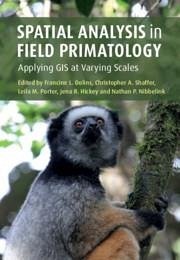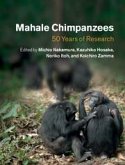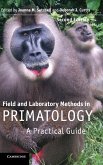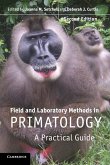Spatial Analysis in Field Primatology
Applying GIS at Varying Scales
Herausgeber: Dolins, Francine L; Nibbelink, Nathan P; Hickey, Jena R; Porter, Leila M; Shaffer, Christopher A
Schade – dieser Artikel ist leider ausverkauft. Sobald wir wissen, ob und wann der Artikel wieder verfügbar ist, informieren wir Sie an dieser Stelle.
Spatial Analysis in Field Primatology
Applying GIS at Varying Scales
Herausgeber: Dolins, Francine L; Nibbelink, Nathan P; Hickey, Jena R; Porter, Leila M; Shaffer, Christopher A
- Gebundenes Buch
Andere Kunden interessierten sich auch für
![Mahale Chimpanzees Mahale Chimpanzees]() Mahale Chimpanzees229,99 €
Mahale Chimpanzees229,99 €![Field and Laboratory Methods in Primatology Field and Laboratory Methods in Primatology]() Field and Laboratory Methods in Primatology120,99 €
Field and Laboratory Methods in Primatology120,99 €![Field and Laboratory Methods in Primatology Field and Laboratory Methods in Primatology]() Field and Laboratory Methods in Primatology68,99 €
Field and Laboratory Methods in Primatology68,99 €![World Archaeoprimatology World Archaeoprimatology]() World Archaeoprimatology122,99 €
World Archaeoprimatology122,99 €![Mama's Last Hug Mama's Last Hug]() Frans De WaalMama's Last Hug9,49 €
Frans De WaalMama's Last Hug9,49 €![Mama's Last Hug Mama's Last Hug]() Frans De WaalMama's Last Hug18,99 €
Frans De WaalMama's Last Hug18,99 €![The Gibbons The Gibbons]() Susan Lappan / Danielle Whittaker (ed.)The Gibbons340,99 €
Susan Lappan / Danielle Whittaker (ed.)The Gibbons340,99 €-
-
-
Produktdetails
- Verlag: Cambridge University Press
- Seitenzahl: 460
- Erscheinungstermin: 18. Februar 2021
- Englisch
- Abmessung: 249mm x 196mm x 25mm
- Gewicht: 1043g
- ISBN-13: 9781107062306
- ISBN-10: 1107062306
- Artikelnr.: 57639823
- Herstellerkennzeichnung
- Libri GmbH
- Europaallee 1
- 36244 Bad Hersfeld
- gpsr@libri.de
Part I. GPS for Primatologists: Introduction Leila M. Porter; 1. Why place
matters, and its use in primate behavioral and ecological research Francine
L. Dolins; 2. Fundamentals of GPS AND GIS Nathan P. Nibbelink and Joanna
Hatt; 3. 'Next-gen' tracking in primatology: opportunities and challenges
Margaret C. Crofoot; 4. The ethical implications, and practical
consequences, of attaching remote telemetry apparatus to macaques Amy
Klegarth, Agustín Fuentes, Lisa Jones-Engel, Greg Marshall and Kyler
Abernathy; 5. Processing geospatial data in R: a primer Allison Howard and
Roger Mundry; 6. Estimating travel distance and linearity of primate
routes: ideas on how to clean and smooth track data collected with a
handheld GPS Karline R. L. Janmaat, Simone D. Ban and Roger Mundry; Part
II. GIS Analysis in Fine-Scale Space: Introduction Christopher A. Shaffer;
7. Home range analysis: why the methods matter Sarah A. Boyle; 8.
Quantifying resource dispersion in free-ranging bearded sakis in Guyana:
what is a patch? Christopher A. Shaffer; 9. Interpreting small-scale
patterns of ranging by primates: what does it mean, and why does it matter?
Mitchell T. Irwin and Jean-Luc Raharison; 10. Determining the presence of
habitual travel route networks in orangutans (pongo pygmaeus morio) in
Kutai National Park, Borneo Adam O. Bebko; 11. Finding fruit in a tropical
rainforest: a comparison of the foraging patterns of two distinct
fruit-eating primates across years Leila M. Porter, Paul Garber,
Christopher Boesch and Karline R. L. Janmaat; 12. Random walk analyses in
primates Amy L. Schreier and Matt Grove; 13. The use of small-scale spatial
analysis to evaluate primate behavior and welfare in captive settings
Stephen R. Ross and Marisa A. Shender; 14. The promise of spatially
explicit agent-based models for primatology research Anthony Di Fiore; Part
III. GIS Analysis in Broad-Scale Space: Introduction Francine L. Dolins;
15. Modeling niches and mapping distributions: progress and promise of
ecological niche models for primate research Kenneth L. Chiou and Mary E.
Blair; 16. Does reduced habitat quality or increased hunter access explain
defaunation of fragmented forests? Bonobos as a case study Jena R. Hickey
and Michael J. Conroy; 17. Landscape ecology of deforestation processes and
lemur biogeography in Madagascar Travis S. Steffens and Shawn M. Lehman;
18. Quantitative methods for primate biogeography and macroecology Jason M.
Kamilar and Lydia Beaudrot; 19. GIS and GPS techniques in an
ethnoprimatological investigation of St Kitts green monkey (chlorocebus
sabaeus) crop-foraging behavior Kerry M. Dore, Daniel Sewell, Eduardo M.
Mattenet and Trudy R. Turner; 20. Conclusion Francine L. Dolins.
matters, and its use in primate behavioral and ecological research Francine
L. Dolins; 2. Fundamentals of GPS AND GIS Nathan P. Nibbelink and Joanna
Hatt; 3. 'Next-gen' tracking in primatology: opportunities and challenges
Margaret C. Crofoot; 4. The ethical implications, and practical
consequences, of attaching remote telemetry apparatus to macaques Amy
Klegarth, Agustín Fuentes, Lisa Jones-Engel, Greg Marshall and Kyler
Abernathy; 5. Processing geospatial data in R: a primer Allison Howard and
Roger Mundry; 6. Estimating travel distance and linearity of primate
routes: ideas on how to clean and smooth track data collected with a
handheld GPS Karline R. L. Janmaat, Simone D. Ban and Roger Mundry; Part
II. GIS Analysis in Fine-Scale Space: Introduction Christopher A. Shaffer;
7. Home range analysis: why the methods matter Sarah A. Boyle; 8.
Quantifying resource dispersion in free-ranging bearded sakis in Guyana:
what is a patch? Christopher A. Shaffer; 9. Interpreting small-scale
patterns of ranging by primates: what does it mean, and why does it matter?
Mitchell T. Irwin and Jean-Luc Raharison; 10. Determining the presence of
habitual travel route networks in orangutans (pongo pygmaeus morio) in
Kutai National Park, Borneo Adam O. Bebko; 11. Finding fruit in a tropical
rainforest: a comparison of the foraging patterns of two distinct
fruit-eating primates across years Leila M. Porter, Paul Garber,
Christopher Boesch and Karline R. L. Janmaat; 12. Random walk analyses in
primates Amy L. Schreier and Matt Grove; 13. The use of small-scale spatial
analysis to evaluate primate behavior and welfare in captive settings
Stephen R. Ross and Marisa A. Shender; 14. The promise of spatially
explicit agent-based models for primatology research Anthony Di Fiore; Part
III. GIS Analysis in Broad-Scale Space: Introduction Francine L. Dolins;
15. Modeling niches and mapping distributions: progress and promise of
ecological niche models for primate research Kenneth L. Chiou and Mary E.
Blair; 16. Does reduced habitat quality or increased hunter access explain
defaunation of fragmented forests? Bonobos as a case study Jena R. Hickey
and Michael J. Conroy; 17. Landscape ecology of deforestation processes and
lemur biogeography in Madagascar Travis S. Steffens and Shawn M. Lehman;
18. Quantitative methods for primate biogeography and macroecology Jason M.
Kamilar and Lydia Beaudrot; 19. GIS and GPS techniques in an
ethnoprimatological investigation of St Kitts green monkey (chlorocebus
sabaeus) crop-foraging behavior Kerry M. Dore, Daniel Sewell, Eduardo M.
Mattenet and Trudy R. Turner; 20. Conclusion Francine L. Dolins.
Part I. GPS for Primatologists: Introduction Leila M. Porter; 1. Why place
matters, and its use in primate behavioral and ecological research Francine
L. Dolins; 2. Fundamentals of GPS AND GIS Nathan P. Nibbelink and Joanna
Hatt; 3. 'Next-gen' tracking in primatology: opportunities and challenges
Margaret C. Crofoot; 4. The ethical implications, and practical
consequences, of attaching remote telemetry apparatus to macaques Amy
Klegarth, Agustín Fuentes, Lisa Jones-Engel, Greg Marshall and Kyler
Abernathy; 5. Processing geospatial data in R: a primer Allison Howard and
Roger Mundry; 6. Estimating travel distance and linearity of primate
routes: ideas on how to clean and smooth track data collected with a
handheld GPS Karline R. L. Janmaat, Simone D. Ban and Roger Mundry; Part
II. GIS Analysis in Fine-Scale Space: Introduction Christopher A. Shaffer;
7. Home range analysis: why the methods matter Sarah A. Boyle; 8.
Quantifying resource dispersion in free-ranging bearded sakis in Guyana:
what is a patch? Christopher A. Shaffer; 9. Interpreting small-scale
patterns of ranging by primates: what does it mean, and why does it matter?
Mitchell T. Irwin and Jean-Luc Raharison; 10. Determining the presence of
habitual travel route networks in orangutans (pongo pygmaeus morio) in
Kutai National Park, Borneo Adam O. Bebko; 11. Finding fruit in a tropical
rainforest: a comparison of the foraging patterns of two distinct
fruit-eating primates across years Leila M. Porter, Paul Garber,
Christopher Boesch and Karline R. L. Janmaat; 12. Random walk analyses in
primates Amy L. Schreier and Matt Grove; 13. The use of small-scale spatial
analysis to evaluate primate behavior and welfare in captive settings
Stephen R. Ross and Marisa A. Shender; 14. The promise of spatially
explicit agent-based models for primatology research Anthony Di Fiore; Part
III. GIS Analysis in Broad-Scale Space: Introduction Francine L. Dolins;
15. Modeling niches and mapping distributions: progress and promise of
ecological niche models for primate research Kenneth L. Chiou and Mary E.
Blair; 16. Does reduced habitat quality or increased hunter access explain
defaunation of fragmented forests? Bonobos as a case study Jena R. Hickey
and Michael J. Conroy; 17. Landscape ecology of deforestation processes and
lemur biogeography in Madagascar Travis S. Steffens and Shawn M. Lehman;
18. Quantitative methods for primate biogeography and macroecology Jason M.
Kamilar and Lydia Beaudrot; 19. GIS and GPS techniques in an
ethnoprimatological investigation of St Kitts green monkey (chlorocebus
sabaeus) crop-foraging behavior Kerry M. Dore, Daniel Sewell, Eduardo M.
Mattenet and Trudy R. Turner; 20. Conclusion Francine L. Dolins.
matters, and its use in primate behavioral and ecological research Francine
L. Dolins; 2. Fundamentals of GPS AND GIS Nathan P. Nibbelink and Joanna
Hatt; 3. 'Next-gen' tracking in primatology: opportunities and challenges
Margaret C. Crofoot; 4. The ethical implications, and practical
consequences, of attaching remote telemetry apparatus to macaques Amy
Klegarth, Agustín Fuentes, Lisa Jones-Engel, Greg Marshall and Kyler
Abernathy; 5. Processing geospatial data in R: a primer Allison Howard and
Roger Mundry; 6. Estimating travel distance and linearity of primate
routes: ideas on how to clean and smooth track data collected with a
handheld GPS Karline R. L. Janmaat, Simone D. Ban and Roger Mundry; Part
II. GIS Analysis in Fine-Scale Space: Introduction Christopher A. Shaffer;
7. Home range analysis: why the methods matter Sarah A. Boyle; 8.
Quantifying resource dispersion in free-ranging bearded sakis in Guyana:
what is a patch? Christopher A. Shaffer; 9. Interpreting small-scale
patterns of ranging by primates: what does it mean, and why does it matter?
Mitchell T. Irwin and Jean-Luc Raharison; 10. Determining the presence of
habitual travel route networks in orangutans (pongo pygmaeus morio) in
Kutai National Park, Borneo Adam O. Bebko; 11. Finding fruit in a tropical
rainforest: a comparison of the foraging patterns of two distinct
fruit-eating primates across years Leila M. Porter, Paul Garber,
Christopher Boesch and Karline R. L. Janmaat; 12. Random walk analyses in
primates Amy L. Schreier and Matt Grove; 13. The use of small-scale spatial
analysis to evaluate primate behavior and welfare in captive settings
Stephen R. Ross and Marisa A. Shender; 14. The promise of spatially
explicit agent-based models for primatology research Anthony Di Fiore; Part
III. GIS Analysis in Broad-Scale Space: Introduction Francine L. Dolins;
15. Modeling niches and mapping distributions: progress and promise of
ecological niche models for primate research Kenneth L. Chiou and Mary E.
Blair; 16. Does reduced habitat quality or increased hunter access explain
defaunation of fragmented forests? Bonobos as a case study Jena R. Hickey
and Michael J. Conroy; 17. Landscape ecology of deforestation processes and
lemur biogeography in Madagascar Travis S. Steffens and Shawn M. Lehman;
18. Quantitative methods for primate biogeography and macroecology Jason M.
Kamilar and Lydia Beaudrot; 19. GIS and GPS techniques in an
ethnoprimatological investigation of St Kitts green monkey (chlorocebus
sabaeus) crop-foraging behavior Kerry M. Dore, Daniel Sewell, Eduardo M.
Mattenet and Trudy R. Turner; 20. Conclusion Francine L. Dolins.








